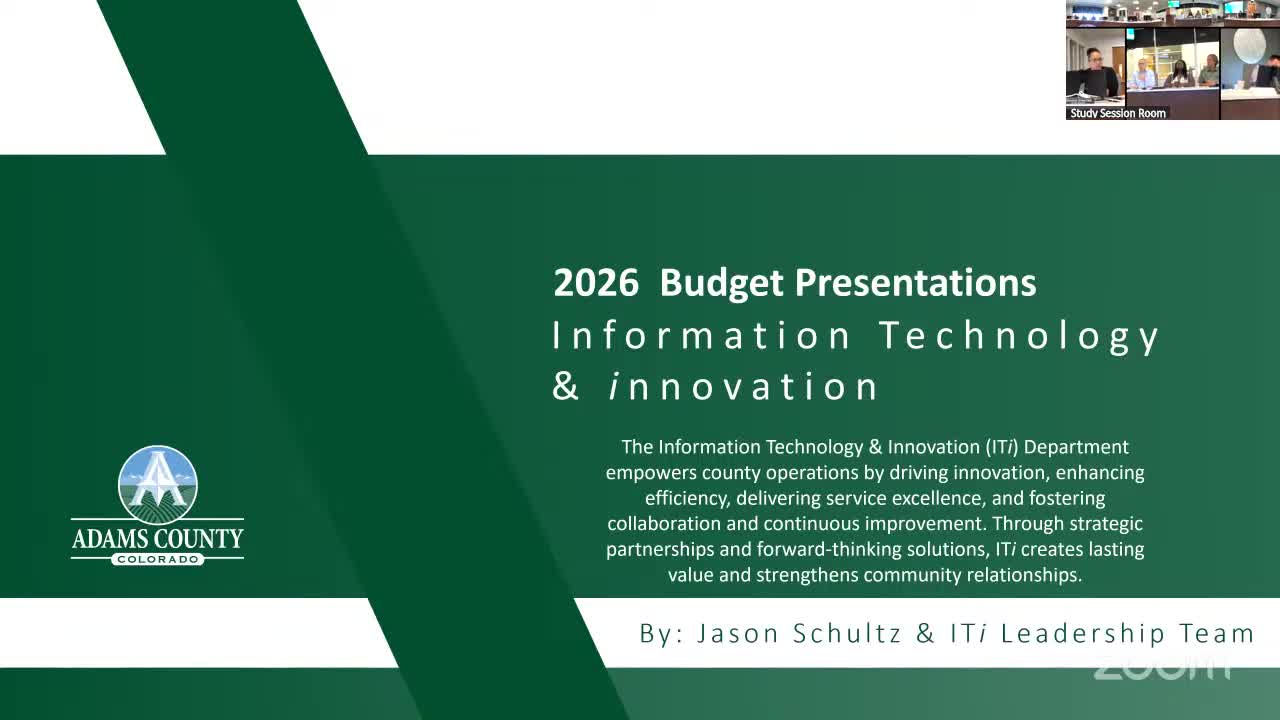Adams County Information Technology Outlines 2026 Goals for Service Delivery and AI Integration
October 02, 2025 | Adams County, Colorado
This article was created by AI summarizing key points discussed. AI makes mistakes, so for full details and context, please refer to the video of the full meeting. Please report any errors so we can fix them. Report an error »

During the Adams County Board of County Commissioners Study Session on October 2, 2025, key discussions centered around the county's Information Technology and Innovation Department's strategic initiatives and budgetary needs for the upcoming year. The meeting highlighted the department's transformation towards a service-oriented model, emphasizing improved service delivery, data governance, and cloud migration.
The department, led by Director Jennifer Council and her team, outlined its five core divisions: Service Delivery and Excellence, Digital Services and Data Management, Platforms and Innovation, Service Operations and Support, and Security Risk and Compliance. Each division plays a crucial role in ensuring efficient and secure services for the county, with a strong focus on customer satisfaction and project management.
A significant topic of discussion was the department's commitment to a high-performing and fiscally responsible government. This involves providing innovative services that enhance operational sustainability and support data-driven decision-making. The department aims to transition from traditional IT practices to a cloud-first approach, which is expected to reduce capital expenditures and allow staff to focus on value-added services rather than maintaining hardware.
Three primary initiatives for 2026 were identified: enhancing service delivery, developing an AI and data governance framework, and migrating enterprise resource planning systems to the cloud. The department is currently on track with its strategic plan, developed in collaboration with Ernst and Young, which includes a comprehensive review of county operations.
The meeting also addressed the need for improved broadband infrastructure in underserved areas, particularly in eastern Adams County. A proposed capital project aims to expand fiber optic networks to enhance connectivity in communities like Strasburg and Bennett. This initiative is expected to facilitate partnerships with internet service providers and leverage grant opportunities to offset costs.
Additionally, the department is seeking to add a full-time project manager to its team to better manage the increasing number of projects, which currently totals 84. This staffing request reflects the growing demand for project management services across various county departments.
In conclusion, the discussions during the study session underscored the county's commitment to leveraging technology for improved service delivery and community engagement. As the county moves forward with its strategic initiatives, the focus will remain on enhancing operational efficiency, expanding digital services, and fostering partnerships to support economic growth and community well-being.
The department, led by Director Jennifer Council and her team, outlined its five core divisions: Service Delivery and Excellence, Digital Services and Data Management, Platforms and Innovation, Service Operations and Support, and Security Risk and Compliance. Each division plays a crucial role in ensuring efficient and secure services for the county, with a strong focus on customer satisfaction and project management.
A significant topic of discussion was the department's commitment to a high-performing and fiscally responsible government. This involves providing innovative services that enhance operational sustainability and support data-driven decision-making. The department aims to transition from traditional IT practices to a cloud-first approach, which is expected to reduce capital expenditures and allow staff to focus on value-added services rather than maintaining hardware.
Three primary initiatives for 2026 were identified: enhancing service delivery, developing an AI and data governance framework, and migrating enterprise resource planning systems to the cloud. The department is currently on track with its strategic plan, developed in collaboration with Ernst and Young, which includes a comprehensive review of county operations.
The meeting also addressed the need for improved broadband infrastructure in underserved areas, particularly in eastern Adams County. A proposed capital project aims to expand fiber optic networks to enhance connectivity in communities like Strasburg and Bennett. This initiative is expected to facilitate partnerships with internet service providers and leverage grant opportunities to offset costs.
Additionally, the department is seeking to add a full-time project manager to its team to better manage the increasing number of projects, which currently totals 84. This staffing request reflects the growing demand for project management services across various county departments.
In conclusion, the discussions during the study session underscored the county's commitment to leveraging technology for improved service delivery and community engagement. As the county moves forward with its strategic initiatives, the focus will remain on enhancing operational efficiency, expanding digital services, and fostering partnerships to support economic growth and community well-being.
View full meeting
This article is based on a recent meeting—watch the full video and explore the complete transcript for deeper insights into the discussion.
View full meeting
